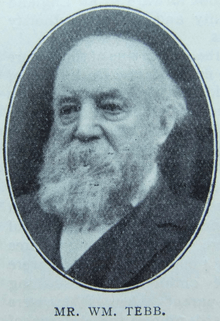William Tebb
William Tebb (22 October 1830 – 23 January 1917) was a British businessman and wide-ranging social reformer. He was an anti-vaccinationist and author of anti-vaccination books.[1][2] He was concerned about premature burial.
William Tebb | |
|---|---|
 William Tebb in 1913 | |
| Born | 22 October 1830 |
| Died | 23 January 1917 (aged 86) |
| Nationality | British |
Biography
Privately educated, Tebb started work at fifteen for a Manchester business, attending evening classes where he encountered the ideas of the British radicals John Bright, Richard Cobden and Robert Owen, and the American Christian social reformer Adin Ballou. His ideas were also influenced by a Salford Swedenborgian sect promoting physical purity, food reform, and teetotalism.
In 1852, Tebb went to the United States as a representative of the Vegetarian Society. He was introduced to Ballou and made frequent visits to the latter's experimental Hopedale Community, where he met and married Mary Elizabeth Scott in 1856.
In the 1850s he became active in the American abolitionist movement, but he and his family returned to England in the 1860s to escape a malaria outbreak, settling in London. Tebb became a director of a company making bleaching chemicals for paper, earning a large fortune that he used to fund a variety of social causes.
He co-founded the Royal Normal College for the Blind, was active in anti-vivisection, contributed to the Royal Society for the Prevention of Cruelty to Animals (becoming a vice-president of the National Canine Defence League) as well as joining the Society for the Prevention of Cruelty to Children and the Humanitarian League. Politically a radical Liberal, he was a member of the Devonshire Club, National Liberal Club, New Reform Club, and the Vigilance Association for the Defence of Personal Rights.
Tebb's daughter Florence married Raphael Weldon.
Anti-vaccination activism
In 1869 Tebb became deeply committed to the anti-vaccination campaign whose aim was repeal of the Vaccination Acts that made smallpox vaccination compulsory for children. He himself was prosecuted and fined thirteen times for refusal to vaccinate his third daughter. In 1880, he co-founded the London Society for the Abolition of Compulsory Vaccination (LSACV) and established its official publication, the Vaccination Inquirer. He served as its chairman until 1896, when it was dissolved to form the National Anti-Vaccination League (NAVL), of which he was president.
He became a highly publicised activist against compulsory smallpox vaccination, and then one of the most prolific writers and activists against vaccination itself. Although interested in spiritualism and theosophy, he campaigned not on religious grounds but on general appeal to values of social liberty.
He visited the United States in 1879, and campaigned against smallpox vaccinations. Smallpox had recently become epidemic again, after a decline in vaccination, following a decline in cases of smallpox earlier in the century. Several American anti-vaccination organisations arose around the time of his visit.[1][3][4]
The NAVL succeeded in its lobbying for a government enquiry (a Royal Commission in 1886), and the 1898/1907 Act of 1898 that introduced exemption from vaccination on grounds of conscientious objection. Although he continued to campaign against vaccination, in later life Tebb took on further causes.
Other interests
In 1895 he moved to Rede Hall, Burstow, Surrey, where he occupied major posts in the parish council, local horticultural society and cricket club. He paid for a monument to Adin Ballou at Hopedale, and a drinking fountain at Burstow in memory of the 400,000 horses killed and wounded during the Boer War, to which he was strongly opposed as a pacifist and anti-imperialist.
Along with Walter Hadwen, in 1896 he had co-founded the London Association for the Prevention of Premature Burial, that campaigned for burial reforms to ensure that those buried were certainly dead.[2] When he died at Burstow in 1917, his will specified that "unmistakable evidence of decomposition" should be visible, so he was cremated a week after his death.
Publications
- Sanitation, not Vaccination the True Protection against Small-Pox, 1881 paper, Second International Congress of Anti-Vaccinators
- Testimonies of Medical Authorities on Vaccination, Preface, 1882, London Society for the Abolition of Compulsory Vaccination
- Compulsory Vaccination in England: with incidental references to foreign states, 1884, E.W. Allen, London
- The Increase of Cancer, 1892, The Tocsin. Booklet reprint 1892, Wertheimer, Lea & Co., London
- Leprosy and Vaccination, 1893, Swan Sonnenschein & Co., London
- Premature burial, and how it may be prevented, with special reference to trance catalepsy, and other forms of suspended animation, ed. Walter Hadwen, Swan, London, 1905
References
- "Opposed To Vaccination. Doctors Who Condemn It. An Englishman's Views on the Subject" (PDF). The New York Times. 11 October 1879. Retrieved 11 February 2015.
A meeting of medical gentlemen was held in the lecture-room of the United States Medical College, No. 114 East Thirteenth-street, last evening, to take steps for the organization of an anti-vaccination society. ...
- Bodily Matters: The Anti-Vaccination Movement in England, 1853–1907, Nadja Durbach, Duke University Press, 2005, ISBN 0-8223-3423-2 – Google Books
- "Biographical Memoir of William Tebb". The Homoeopathic Physician. 1899. p. 407.
- "History of Anti-vaccination Movements". College of Physicians of Philadelphia. 8 March 2012. Retrieved 11 February 2015.
The Anti Vaccination Society of America was founded in 1879, following a visit to America by leading British anti-vaccinationist William Tebb. Two other leagues, the New England Anti Compulsory Vaccination League (1882) and the Anti-vaccination League of New York City (1885) followed. ...
Further reading
- Nadja Durbach, "Tebb, William (1830–1917)", Oxford Dictionary of National Biography, online edn, Oxford University Press, May 2006 accessed 16 Aug 2007